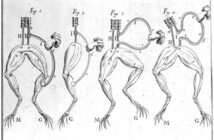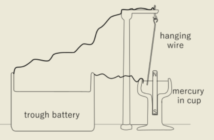Luigi Aloisio Galvani was born in Bologna, Papal States, Italy, in 1737. He wanted to study theology, but since his parents wanted their son to be a doctor, he studied medicine instead. At the University of Bologna (1762), he was appointed as a public lecturer in anatomy and soon became known as a talented educator and scientist, predominantly because of his work on the genito-urinary system and the hearing organs of birds.
Galvani discovered what we now know as the electrical basis of nerve impulses. He assembled an instrument in which a dead frog’s nerve was connected to a terminal of one metal and the frog’s muscle to a terminal of another metal. He demonstrated that the animal body develops spastic movements when power passes through it.

Alessandro Volta, the inventor of the first battery, was Galvani’s contemporary. Volta was one of the most adamant opponents Galvani’s conclusions, since he believed that ‘animal electricity’ did not exist. Volta argued that Galvani’s observations had to do with the way two different metals react to each other. The two scientists were still friends, though. It was Volta, in fact, that suggested the term “galvanism” to describe an electrically-induced muscle contraction.
Unlike Volta, and many other scientists, Galvani did not benefit from Napoleon’s reign. He refused to pledge allegiance to Napoleon’s new republic, lost his position at the university, and lived out his days on his brother’s couch.
Galvani’s legacy may be seen primarily in electrophysiology and neuroscience. His experiments and theories were also Mary Shelley’s inspiration when she wrote the classic novel Frankenstein.
Related Articles:
Alessandro Volta: Father of Modern Battery
Voltaic Pile: First Electrochemical Cell
How to Generate Current Through Human Battery?
What metals are used in batteries?
What are the most common battery terminals?



